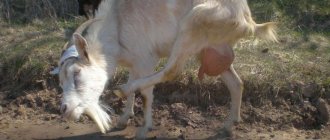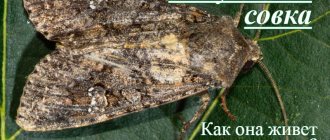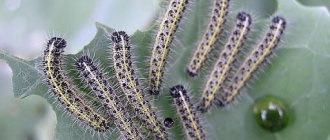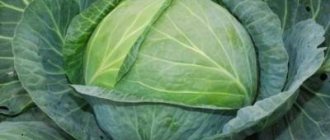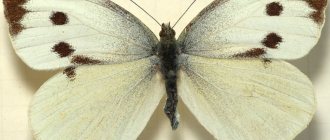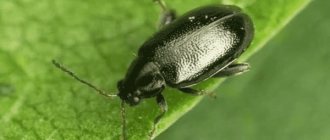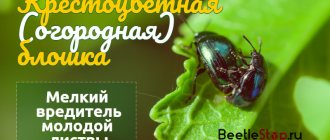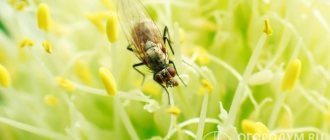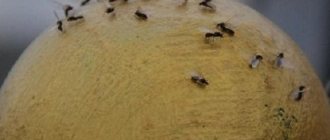- Description of the pest
- Types of cabbage flies and their life cycle Spring cabbage fly
- Summer cabbage fly
- Agrotechnical method and prevention of the appearance of cabbage fly
Despite its harmless appearance, the cabbage fly is a very dangerous pest of cabbage and other garden crops belonging to the Cruciferous family. With a massive attack of these flies on cabbage beds, the crop can be ruined in less than a month.
The adult insect does not harm cabbage, but its larvae have an increased appetite and feed almost constantly. This article will talk in detail about this pest, and will also provide effective ways to combat cabbage fly.
Cabbage fly: description
The cabbage fly is a dangerous pest that can destroy cabbage, radish and other cruciferous crops in a short period of time. If you do not prevent the appearance of an insect, it is more difficult to get rid of it. But a competent approach and timely measures will help solve the problem.
It is more difficult to see the cabbage fly itself; its presence is recognized by the appearance of a small worm on the leaves. It looks like a codling moth, but is smaller in size. This is the larva of the cabbage fly that feeds on the roots of crops. Plants begin to wither, dry out, and it seems that they do not have enough water. But watering in this case does not restore the crop.
Video - Cabbage fly:
The cabbage fly is widespread throughout Europe, Siberia, and Central Asia. In Russia, the pest is found almost throughout the entire territory.
The cabbage pest belongs to the family of flower flies. The size reaches 1 cm, insects are not noticeable. Invisible, as they are painted inconspicuously:
- females – light ash;
- males are darker in color.
The cabbage fly is not much different from the house fly. You can recognize it by its dark stripe on the abdomen and three longitudinal stripes on the chest.
The insect causes significant harm to plants, which consists of:
- the larvae must feed, so they constantly consume cabbage root;
- gradually the root system is completely destroyed and the plant dies;
- usually during this period, pupae are formed, and the second generation of insects is born, which move to new plants.
Up to 4 generations can hatch in one growing season. But the crops become stronger and more powerful, so towards the end of summer the damage from insects is not so felt.
Types of cabbage flies
There are 2 types of cabbage fly that are found in the garden:
- spring;
- summer
Spring cabbage fly
Both pests are similar in appearance, although the body color of the second insect is slightly darker. Representatives of the summer group are slightly larger in size (females - up to 7.5 mm, males -5.5) than spring pests (body length up to 6 mm).
Cycle of life
The emergence of insects occurs during the flowering period of fruit crops. The spring midge appears on the street with the beginning of lilac flowering. The summer cabbage fly emerges 2-3 weeks later.
Only a few days pass from the moment of departure to mating. After 2 weeks, females lay eggs. One fly can lay up to 150 pieces in a clutch, which is located directly under the top layer of soil near the root system of, for example, cabbage.
After 10 days, the larvae emerge from their shelter and begin to destroy the root system of cruciferous plants. They penetrate under the shell of cabbage roots or bite into root vegetables (turnips, radishes, radishes, daikon).
To detect egg laying, use a fork to lightly tear up the soil near the plant at the place where the stem meets the root. A cluster of white dots will indicate the presence of a clutch of eggs. They are no larger than the eye of a needle. They are carefully scraped off the stem and destroyed.
From this moment the insect damage to plants begins. In fact, flies themselves are not dangerous; on the contrary, they act as pollinators. But the larvae are capable of destroying cabbage, radish and other cruciferous garden crops.
Photo: The main danger is larvae
After approximately 20-21 weeks (it all depends on the air temperature), the insects develop in the soil and feed on plant juices, then degenerate into a pupa. The adult insect (imago) will emerge in another 20 days.
The last generation goes into the ground in the form of a puparia. In this form they overwinter at a depth of 10-15 cm.
Conclusion
To destroy cabbage whites, you need to combine different means. Much depends on the degree of damage to the plantings, the number of weeds, and the weather. The sooner measures are taken, the greater the chances of preserving the harvest and preventing the appearance of pests next year.
- How to get rid of cabbage butterflies: what it looks like, what it prefers, an overview of mechanical, chemical and folk methods of control, their pros and cons
- How to deal with the pea codling moth: a description of the pest, why it is dangerous, an overview of the main methods of combating it - agricultural technology, folk recipes, biological methods, chemicals, their pros and cons
- How to protect cabbage from caterpillars: types of pests, causes of occurrence, how to detect them, prevention, review of control methods - mechanical, biological, chemical, folk, their pros and cons
- How to deal with carrot fly: description of the pest, signs of infection, what crops it affects, review of chemicals and traditional methods, prevention tips
Causes and signs of appearance
There are no specific reasons for the appearance of cabbage fly. With the beginning of flowering, the insect flies out of its hiding place and begins to look for food.
It is very important to notice a harmful insect on your site and start fighting in a timely manner.
The first symptom that a pest has taken a fancy to the garden bed will be its appearance above the plantings. Midges will hover over cabbage, radishes or radishes without causing harm.
Active life activity leads to withering
The negative impact is caused by the larvae that the fly deposits in the soil near the root system of plants. After the larvae hatch from the eggs, the following signs will be noticeable:
- the plant begins to wither, as the pest damages the root system, even abundant watering will not restore the leaves;
- Cabbage leaves take on a lilac-lead hue.
When such signs appear, they begin to actively fight the pest in order to save the plants.
Cabbage gnawing pests
The group of gnawing pests of cabbage is numerous, but the most common causes of damage are cabbage cutworms, white butterfly caterpillars, cabbage moths, cabbage flies and cruciferous flea beetles. The latter damage cabbage seedlings, destroying young leaves.
Cabbage scoop
Cabbage moth caterpillars can be of different colors, but they do the same amount of damage.
Photo: ResearchGate Cabbage cutworms are pests that damage not only cabbage, but also other vegetable crops, fruit plants, and flowers. Our website has a detailed article on combating all types of cutworms.
Cabbage is damaged by cutworm caterpillars, and the butterflies themselves are invisible during the day because they lead an exclusively nocturnal lifestyle, and during the day they sleep on walls and fences, covered with their wings and sit motionless, waiting for the evening.
Cutworms are extremely harmful throughout the summer; they lay thousands of eggs on the underside of cabbage leaves, from which a week later green caterpillars emerge (may be brown), which eat the plant “down to the skeleton” in a few days, and then crawl to neighboring bushes and continue feast there.
In the southern regions, cabbage cutworms manage to form 3 generations of pests, and in temperate latitudes - one. After feeding on cabbage, cutworm caterpillars burrow 8-10 cm into the soil and overwinter there in the form of pupae and larvae.
Cabbage fly
Cabbage fly larvae damage the root collar of cabbage. Photo: Warren Photographic
The cabbage fly harms cabbage on the sly - at the end of May it lays eggs near cabbage of all types, from which larvae emerge a week later and begin to gnaw the stem. When the roots and bottom of the stem are sufficiently damaged, the plant wilts and a leaden tint appears on the leaves.
Thus, the cabbage fly larvae remain unnoticed by the gardener until the plants die.
Cabbage moth
The green cabbage moth caterpillar (Plutella xylostella) damages cabbage. Photo: Bettaman/Flickr.com
Like cutworms, cabbage is damaged by small greenish caterpillars of the cabbage moth, and the moth itself flutters from plant to plant and lays hundreds of eggs starting in May-June. In total, 5-6 generations of cabbage moths develop over the summer, unless, of course, you fight them with all available methods.
Cabbage moth caterpillars grow quickly and devour cabbage leaves around the clock, without breaks for lunch, so every one and a half to two months new recruits are added to the pest regiment.
Cabbage whites
Cabbage butterfly caterpillars eat a cabbage leaf. Photo: Wikimedia Commons
The caterpillars of the white butterfly are known to most gardeners, as are the butterflies themselves, fluttering between plants. Essentially, the cabbage white is a moth with white wings on which there are black spots.
In one sitting, the white butterfly lays about a hundred eggs, from which, after one and a half to two weeks, voracious caterpillars hatch, eating the whole cabbage, with the exception of the veins. In addition to eating, they also spoil cabbage leaves with smelly greenish secretions.
A cabbage bush affected by cabbage white caterpillars can be smelled with your nose from afar - the aroma of the caterpillars' secretions overwhelms all the odors around, especially after watering or rain.
Cruciferous flea beetle
Cruciferous flea beetles on cabbage cotyledon leaves. Photo: Field Crop News
Cruciferous flea beetles damage not only all types of cabbage: white cabbage, red cabbage, Chinese cabbage, kohlrabi, cauliflower, etc., but also radishes, mustard, radishes, turnips, etc. The insects are nicknamed fleas for their exceptional sneakiness; as soon as you touch the plant, the fleas jump into different sides.
Flea beetles cause the greatest harm to cabbage seedlings and young shoots, but large plants are less interesting to them. Having fed on cabbage, radishes and radishes, flea beetles multiply vigorously, and for the winter they go into the soil or into piles of plant debris.
Slugs, mole crickets, wireworms
Slugs feed on the pulp of cabbage leaves at night, and for daytime sleep they settle in the shade of the leaves of the cabbage head, which serves as food for them. If the edges of the cabbage leaves are eaten away, then you should look for slugs by looking into the most secluded corners of the cabbage leaves.
Mole crickets gnaw cabbage from under the ground, damaging the root system and root zone of the stems. It is difficult to fight mole crickets, so a separate article is devoted to them: “Destroy mole crickets: 6 ways to combat the pest.”
The wireworm ruined the cabbage seedlings. Photo: Nova Scotia Vegetable Blog
The wireworm bores holes in the underground parts of cabbage plants, causing the roots and stem to rot. Two articles in our magazine are devoted to the wireworm: “Wireworm: methods of control and prevention” and “Wireworm - pest No. 1”.
Fighting methods
For protection, 4 methods of struggle are traditionally used:
- prevention;
- traps and repellents;
- prevention.
The best option is to prevent the appearance of insects using various agrotechnical measures and preventive treatments. If you prevent the insect from laying eggs, especially in early spring, the crops will become stronger and the pest will not be so scary for them.
Agrotechnical methods of control
If you follow basic agrotechnical measures, you can prevent the appearance of cabbage flies in the garden.
- Circles are cut out of a sheet of paper (diameter 15 cm). A slot is made in the center for the seedling. When planting, put it on each plant and press the circle to the ground. Since the cabbage fly lays its eggs directly on the soil, they will end up on the leaf and gradually dry out.
- Maintaining crop rotation. You cannot grow crops that the pest loves in one place in a row. When planting cabbage, you should avoid the proximity of radishes. It is this crop that the insect loves most.
- Soil renewal. To remove cabbage fly larvae, you can remove a layer of soil 10-15 cm deep from the plant. Instead, add fresh soil, which should be disinfected beforehand.
- Hilling. Cabbage plantings should be regularly hilled and weeded. This procedure stimulates the formation of an additional root system and also repels the larvae. The pest does not like changing conditions or temperature changes.
If there is no layer of mulch, then the cabbage is constantly hilled.
Sometimes such simple measures help fight the pest much more effectively than frequent treatments with insecticides.
Chemicals
Most often, cabbage fly control is carried out using chemicals - insecticides. This method is fast and effective.
When treating adult plants with chemicals, take into account that the chemical components retain their effect when watered for about 60 days, and when sprayed - 30.
Among the most popular insecticides it should be noted:
- Topaz . A chemical preparation that is used to control various vegetable garden pests, including cabbage fly and its pests. It is advisable to treat the seedlings with a similar composition 2 days before planting in a permanent place. 1 ampoule of the drug is diluted in a bucket of water.
- Karbafos . Use the solution to destroy the pest or prevent its occurrence. Add 60 grams to a bucket of water. the drug and treat the plants 2 times with an interval of 7 days.
- Zemlin . Insecticide of contact-intestinal action. It is applied to the soil before planting at a rate of 3-5 kg per m2, deepened by 2 cm.
- Actellica . A broad-spectrum drug. 5 ml of product are diluted in 10 liters of water. Since the composition contains toxic substances with a specific odor, it is necessary to use personal protective equipment during processing.
- Chlorophos . Helps in the fight against larvae. Cope with the pest in almost a day. To prevent repeated damage, plantings are treated again after 1.5-2 months.
- Bazudin . The treatment is effective during the egg laying period.
- Bankol . It contains marine annelids. 20 ml of the drug are diluted in 10 liters of water. Approximately 1 liter of solution is consumed per 10 m2.
It is best to use chemicals before the pest appears, a few days before planting the seedlings. If the larvae have already appeared, then getting rid of them is much more difficult.
Folk recipes
Cabbage fly activity occurs in the summer. But there is no point in waiting for a massive invasion. After the first signals, they begin to use various folk methods that can scare away and destroy the pest.
Video - Fighting methods:
The main advantage of folk recipes is that they can be used at any stage of the plant’s growing season.
Birch tar
This composition will repel the pest with a specific smell and protect the cabbage beds. Dilute 1 tbsp in a bucket of water. l. birch tar and water the plants.
To achieve maximum effect, two treatments are carried out. The interval between waterings should be at least 6-10 days.
Repellent solution based on tobacco dust
To prepare this composition you will need:
- tobacco dust;
- wood ash;
- slaked lime or camphor;
- naphthalene.
All ingredients are mixed in equal proportions. The resulting composition pollinates plants closer to the soil.
Ammonia
A product prepared with ammonia will not only repel the annoying fly, but also destroy the pest.
Add 5 ml of ammonia to a bucket of water. The resulting mixture is watered over the bushes. This can be done several times a season if there are signs of wilting for no reason.
Bay leaf
The cabbage fly simply cannot stand the smell of this seasoning. To prepare the solution, brew 10 g. bay leaf and spray the leaves of the crop. The processing can be repeated several times.
Crushed laurel, which is scattered over a bed of radishes or cabbage, also repels the insect.
Cinnamon
The pest cannot tolerate the smell of cinnamon. The fragrance can be used in a variety of ways. Crushed cinnamon is scattered around the perimeter of the bed.
Cinnamon sticks are placed in holes before planting seedlings. It is also effective to add powder when watering seedlings.
Burdock infusion
To prepare the solution, you should collect 2.5 kg of green raw materials. The leaves are crushed and 10 liters of water are poured. Insist for 2 days.
The resulting composition is filtered, and then the plants are generously sprayed, carefully treating the root stem.
Infusion of tomato tops
This product helps get rid of this dangerous pest. To prepare the solution, use the stepsons of tomatoes. 1 cup of green crushed mass is added to 10 liters of water.
The remedy is infused for 24 hours. In order for the solution to adhere to the foliage, add 40 grams to a bucket of water. crushed laundry soap. The resulting mass is generously sprayed onto the plants.
Valerian tincture
The smell of this drug is also not tolerated by the pest. To prepare the composition, mix:
- 3 liters of warm water;
- 40 ml (1 bottle) valerian tincture;
- 2 tbsp. l. crushed laundry soap.
All components are mixed until completely dissolved. The resulting composition is poured into a bucket and brought to 10 liters with water. Plants should be sprayed at the seedling stage (after planting).
Vinegar water
To prepare the composition, use vinegar essence (70%) or regular table vinegar (9%). If the latter option is used, then 0.5 tbsp is poured onto the bucket.
The product is thoroughly mixed and sprayed on the beds with cruciferous crops. After some time, the treatment can be repeated.
Cruciferous flea beetles
These dangerous pests begin their activity at the moment when the soil just begins to thaw. At first they feed on weeds, after which they move on to cultivated plants. Therefore, flea beetles must be regularly weeded out, otherwise they will haunt not only cabbage, but also radishes, radishes, mustard, turnips and other plants. If flea beetles multiply, they can destroy entire seedlings of cabbage and other plants of the family in a few days.
The larvae of the cruciferous flea beetle are located in the horse system and feed on roots and root crops. After ripening, they come out and move onto the leaves, causing the plant to dry out.
Methods for controlling cruciferous flea beetles
Dusting with ash will help in the fight against massive flea infestations. It’s even better if you mix the ash with tobacco dust in a 1:2 ratio. Typically, flea beetles are especially active in dry weather. Therefore, you need to water the plantation and then immediately powder it.
Infusions of celandine, chamomile, tobacco and garlic also help against fleas. To prepare an infusion of celandine, you need from 3 to 4 kg of herbs. It is filled with a bucket of water and left for 24 hours. The garlic infusion is infused for the same amount of time. It requires 50 g of crushed cloves per bucket of water. You will need 1 kg of chamomile per 10 liters, infuse for 12 hours. Tobacco takes the longest to infuse – two days. It will require 400 g per bucket.
Prevention
All measures to combat cabbage midges can be divided into 2 large groups: prevention and practice. Sometimes the former are much more effective. If we carry out a number of preliminary procedures, the pest will bypass the planting and we will choose another place to lay eggs.
You can plant strong-smelling flowers near cabbage
- Regular inspection of beds. If pest larvae are found in the soil, then cabbage should not be planted in such an area.
- You can protect cruciferous crops with a natural barrier of strong-smelling plants. To do this, marigolds, calendula, and dill are planted near cabbage or radishes.
- In autumn, weeds are removed from the site so that the insect cannot overwinter in them.
- After harvesting, the beds are dug up.
- Purchased seedlings need to be processed. Before planting, the roots are dipped in clay mash (Bitoxiballicin (1%) and a little cow manure are added to the liquid clay solution). After this treatment, the larvae will die.
- After harvesting the cabbage, all remains (stems, old leaves) are taken outside the site and destroyed.
- Before planting seedlings, the horse system is treated with Actava solution (3 grams of the drug is added to 10 liters of water).
- Spray the seedlings and treat the roots of the seedlings before planting with a weak solution of potassium permanganate.
Useful tips
Over the many years of fighting cabbage fly, gardeners have developed many tricks. Taking into account their recommendations, you can easily prevent the appearance of a dangerous pest.
- Natural substances with a strong odor (mustard, garlic, hot pepper, dandelion, mothballs, tobacco, wormwood) repel flies.
- A natural plant barrier can be planted next to the cabbage. Parsley, coriander, sage, and carrots will help repel the pest.
- It is important to ensure that cruciferous weeds (sverbige, rapeseed and others) do not grow in the area.
- If cabbage, radishes or other crops go bad, the plant is removed, as the inflorescences will attract the pest.
- The fly will not be able to lay eggs if the soil in the garden bed is dusted with wood ash or a layer of coarse mulch is poured (wood shavings, shredder paper).
- From the moment the lilacs bloom, stretch a net over the bed with cabbage seedlings to prevent flies from getting to the plants.
- Cabbage should be planted before persistent warm weather sets in. During this time, the plants will have time to get stronger and will be able to resist the pest larvae for the first time.
- Cruciferous crops are planted in beds where garlic or onions grew in the previous season.
Fertilizing with wood ash repels pests
Effective folk remedies
To solve this problem, various chemicals are produced (Zemlin, Karbafos, Lepidotsid, Actellik), but in their absence or to increase efficiency, it is recommended to use folk methods:
Important! You can install special lids made of plastic or cardboard under the cabbage. They make a cutout for the stem. These devices will prevent flies from laying eggs near the root collar.
Insecticides and traditional methods solve the problem, but they must be used before planting the cabbage in the ground and periodically as it grows. If you miss the moment of appearance of the larvae and their further transformation into pupae, then growing the crop will be problematic due to the birth of new generations of cabbage flies.
The main mistakes of gardeners
Very often, inexperienced gardeners make a number of mistakes that provoke the appearance of cabbage flies in the beds.
- Planting a crop for several years in one place.
- Location next door to radish cabbage.
- Planting seedlings in untreated soil.
- The soil has not been updated. Before planting cabbage, 10-15 cm of soil should be removed and new soil should be added, which must first be disinfected.
If there is no control, the cabbage fly quickly destroys the crop
. You need to get rid of the cabbage fly promptly. If it is not possible to prevent the appearance of a dangerous pest, quickly treat the affected seedlings with special insecticides. Often traditional methods are much more effective.
Chemicals
One of the common ways to combat insects, of course, is to treat plants with pesticides. Currently, there is a whole arsenal of drugs that effectively destroy cabbage flies. All you have to do is go to the market or a specialty store and buy it. Next, read the directions for use on the label and act.
You can use drugs such as Karbofos or Bazudin.
If you are not a supporter of the use of chemicals, then the cabbage fly, against which almost all measures are effective, can be easily destroyed using natural ingredients.

